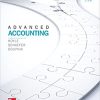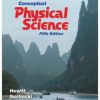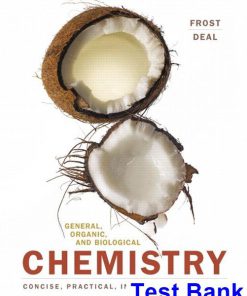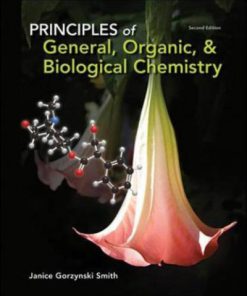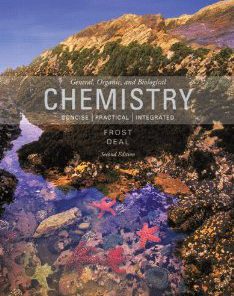Fundamentals of General Organic and Biological Chemistry 8th Edition McMurry Test Bank
$35.00 Original price was: $35.00.$26.50Current price is: $26.50.
Fundamentals of General Organic and Biological Chemistry 8th Edition McMurry Test Bank
Instant download Fundamentals of General Organic and Biological Chemistry 8th Edition McMurry Test Bank pdf docx epub after payment.
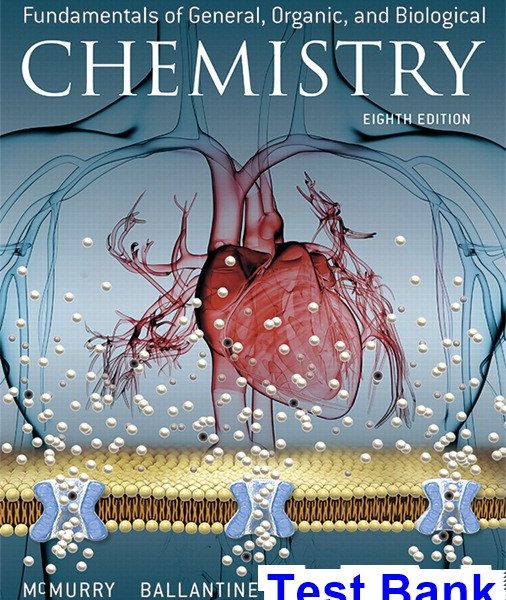
Fundamentals of General, Organic, and Biological Chemistry, 8e (McMurry) Chapter 2 Atoms and the Periodic Table
1) The smallest amount of an element that retains that element’s characteristics is the
- A) atom.
- B) electr C) molecule. D) neutron. E) proton. Answer: A Diff: 1
Section: 2.1
LO: 2.1
Global LO: G2
2) Another name for atomic mass unit (amu) is the
- A) avogadr B) dalton.
- C) Kekule
- D) kelvi
- E) mendelee Answer: B Diff: 1
Section: 2.1
LO: 2.1
Global LO: G2
3) Which characteristics correctly describe a proton?
- A) approximate mass 1 amu; charge +1; inside nucleus
- B) approximate mass 5 × 10-4 amu; charge -1; outside nucleus
- C) approximate mass 5 × 10-4 amu; charge +1; inside nucleus
- D) approximate mass 1 amu; charge 0; inside nucleus
- E) approximate mass 1 amu; charge +1; outside nucleus
Answer: A Diff: 1
Section: 2.1
LO: 2.2
Global LO: G2
4) Which particle has a mass approximately equal to the mass of a proton? A) atom
- B) electron C) neutron D) nucleus E) quark Answer: C Diff: 1
Section: 2.1
LO: 2.2
Global LO: G2
5) Protons possess a charge, and neutrons possess a charge. A) negative; negative
- B) negative; positive C) positive; negative D) positive; zero
- E) zero; positive
Answer: D Diff: 1
Section: 2.1
LO: 2.2
Global LO: G2
6) Protons possess a charge, and electrons possess a charge. A) negative; negative
- B) negative; positive C) positive; negative D) positive; zero
- E) zero; positive
Answer: C Diff: 1
Section: 2.1
LO: 2.2
Global LO: G2
7) Which characteristics correctly describe a neutron? A) approximate mass 1 amu; charge +1; inside nucleus B) approximate mass 1 amu; charge -1; inside nucleus C) approximate mass 1 amu; charge 0; inside nucleus
- D) approximate mass 5 × 10-4 amu; charge 0; inside nucleus
- E) approximate mass 5 × 10-4 amu; charge -1; outside nucleus
Answer: C Diff: 1
Section: 2.1
LO: 2.2
Global LO: G2, G4
8) Which characteristics correctly describe an electron? A) approximate mass 1 amu; charge +1; inside nucleus B) approximate mass 1 amu; charge -1; inside nucleus C) approximate mass 1 amu; charge 0; inside nucleus
- D) approximate mass 5 × 10-4 amu; charge 0; inside nucleus E) approximate mass 5 × 10-4 amu; charge -1; outside nucleus Answer: E
Diff: 1
Section: 2.1
LO: 2.2
Global LO: G2, G4
9) In a neutral atom the number of is equal to the number of . A) protons; electrons
- B) protons; neutrons
- C) neutrons; electrons
- D) protons + electrons; neutrons
- E) none of the above
Answer: A Diff: 1
Section: 2.1
LO: 2.2
Global LO: G2
10) Which statement is incorrect according to modern atomic theory? A) Some sugars have the formula C3.5H7O3.5.
- B) An atom of 14N has the same approximate mass as an atom of 14C.
- C) An atom of 14N behaves differently in chemical reactions than an atom of 14C. D) An example of a chemical reaction is CaCO3 → CaO + CO2.
- E) C2H6 and C3H8 are both possible compounds of carbon and hydroge
Answer: A Diff: 2
Section: 2.1
LO: 2.1
Global LO: G2
11) Where is most of the mass of an atom concentrated? A) electrons
- B) neutrons C) nucleus D) orbitals E) protons Answer: C Diff: 2
Section: 2.1
LO: 2.1
Global LO: G2
12) An atom with Z = 26 and A = 58 contains protons and neutrons. A) 26; 58
- B) 58; 26
- C) 26; 32
- D) 32; 26
- E) 26; 84
Answer: C Diff: 1
Section: 2.2, 2.3
LO: 2.2, 2.3
Global LO: G4
13) An atom with Z = 35 and A = 80 contains protons, electrons, and
neutrons. A) 35; 35; 80
- B) 80; 35; 35
- C) 35; 35; 45
- D) 45; 80; 45
- E) 45; 80; 35
Answer: C Diff: 1
Section: 2.2, 2.3
LO: 2.2, 2.3
Global LO: G4
14) The atomic number of an atom containing 29 protons, 29 electrons, and 34 neutrons is
- A) B) 29. C) 34. D) 58. E) 63.
Answer: B Diff: 1
Section: 2.2, 2.3
LO: 2.2, 2.3
Global LO: G4
15) An atom containing 47 protons, 47 electrons, and 60 neutrons has a mass number of
- A) B) 47. C) 60. D) 107. E) 154.
Answer: D Diff: 1
Section: 2.2, 2.3
LO: 2.2, 2.3
Global LO: G4
16) The value of Z for an atom containing 47 protons, 47 electrons, and 60 neutrons is
- A) B) 47. C) 60. D) 107. E) 154.
Answer: B Diff: 1
Section: 2.2, 2.3
LO: 2.2, 2.3
Global LO: G4
17) The value of Z for the element 37Ar is
- A)
- B) 945. C) 19.
- D) 945. E) 18. Answer: E Diff: 1
Section: 2.2, 2.3
LO: 2.2, 2.3
Global LO: G4
18) For the isotope 71Ga, Z = and A = . A) 31; 40
- B) 71; 31
- C) 71; 40
- D) 31; 71
- E) 31; 69.723
Answer: D Diff: 1
Section: 2.2, 2.3
LO: 2.2, 2.3
Global LO: G4
19) The mass number of Bromine-81 is
- A)
- B) 904. C) 79.
- D) E) 35. Answer: A Diff: 1
Section: 2.2, 2.3
LO: 2.2, 2.3
Global LO: G4
20) How many neutrons does an atom of Ti have? A) 0
- B) 22
- C) 24
- D) 46
- E) 68
Answer: C Diff: 2
Section: 2.2, 2.3
LO: 2.2, 2.3
Global LO: G4
21) Atoms of Cl contain protons and electrons. A) 17; 17
- B) 17; 18
- C) 18; 17
- D) 35; 18
- E) 35; 17
Answer: A Diff: 2
Section: 2.2, 2.3
LO: 2.2, 2.3
Global LO: G4
22) An atom with a mass number of 58 and 32 neutrons will have protons. A) 16
- B) 26
- C) 32
- D) 58
- E) 90
Answer: B Diff: 2
Section: 2.2, 2.3
LO: 2.2, 2.3
Global LO: G4
23) The symbol of the element with 23 protons is
- A) Mg. B) Na. C) V. D) B.
- E) none of the above
Answer: C Diff: 2
Section: 2.2, 2.3
LO: 2.2, 2.3
Global LO: G4
24) An atom with Z = 31 and A = 69 contains protons and neutrons. A) 31; 69
- B) 69; 31
- C) 31; 38
- D) 38; 31
- E) 31; 100
Answer: C Diff: 2
Section: 2.2, 2.3
LO: 2.2, 2.3
Global LO: G4
25) The value of A for an atom containing 29 protons, 29 electrons, and 34 neutrons is
- A) B) 29. C) 34. D) 58. E) 63.
Answer: E Diff: 2
Section: 2.2, 2.3
LO: 2.2, 2.3
Global LO: G4
26) The value of Z for an atom containing 29 protons, 29 electrons, and 34 neutrons, is
- A) B) 29. C) 34. D) 58. E) 63.
Answer: B Diff: 2
Section: 2.2, 2.3
LO: 2.2, 2.3
Global LO: G4
27) The number of neutrons in an atom is equal to
- A) atomic number – mass number. B) mass number – atomic number. C) the atomic number.
- D) the mass number. Answer: B
Diff: 2
Section: 2.2, 2.3
LO: 2.2, 2.3
Global LO: G4
28) An atom that contains 47 protons, 47 electrons, and 60 neutrons is an isotope of
- A) Ag. B) C) Nd. D) Bh.
- E) cannot be determined from the information given
Answer: A Diff: 2
Section: 2.2, 2.3
LO: 2.2, 2.3
Global LO: G4
29) An isotope with 15 protons and 17 neutrons will have which symbol? A) Cl
- B) Cl C) P D) P E) P
Answer: C
Diff: 2
Section: 2.2, 2.3
LO: 2.2, 2.3
Global LO: G4
30) Consider the isotope Br. The atomic number is , and the mass number is
.
- A) 79; 35
- B) 35; 79
- C) 44; 35
- D) 35; 44
- E) 35; 114
Answer: B Diff: 2
Section: 2.2, 2.3
LO: 2.2, 2.3
Global LO: G4
31) Cobalt is element 27. Cobalt-60 is used in the medical treatment of cancer. How many neutrons and protons are contained in the nucleus of this isotope?
- A) 27 neutrons, 33 protons B) 33 neutrons, 27 protons C) 27 neutrons, 27 protons D) 33 neutrons, 33 protons E) 60 neutrons, 27 protons Answer: B
Diff: 2
Section: 2.2, 2.3
LO: 2.2, 2.3
Global LO: G4
32) Hydrogen exists as three isotopes. These isotopes differ by the number of
contained in the atom. A) neutrons
- B) protons C) electrons D) charges E) particles Answer: A Diff: 2
Section: 2.3
LO: 2.3
Global LO: G4
33) Adding one proton to the nucleus of an atom
- A) converts it to an isotope of the same eleme
- B) increases its atomic mass by one unit, but does not change its atomic number. C) increases its atomic number by one unit but does not change its atomic mass. D) does not change either its atomic number or its atomic mass.
- E) converts it to an atom of a different eleme Answer: E
Diff: 1
Section: 2.3
LO: 2.3
Global LO: G4
34) Adding one neutron to the nucleus of an atom
- A) converts it to an isotope of the same eleme
- B) increases its atomic mass by two units, but does not change its atomic number. C) increases its atomic number by one unit but does not change its atomic mass. D) does not change either its atomic number or its atomic mass.
- E) converts it to an atom of a different eleme Answer: A
Diff: 1
Section: 2.3
LO: 2.3
Global LO: G2
35) Naturally occurring iron contains 5.82% 54Fe, 91.66% 56Fe, 2.19% 57Fe, and 0.33% 58Fe. The respective atomic masses are 53.940 amu, 55.935 amu, 56.935 amu, and 57.933 amu. Calculate the average atomic mass of iron.
Answer: 55.847 amu. Diff: 2
Section: 2.3
LO: 2.3
Global LO: G2
36) An imaginary element Xq consists of two isotopes having masses of 100.0 amu and 102.0 amu. A sample of Xq was found to contain 20.0% of the 100Xq isotope and 80.0% of the 102Xq. Calculate the atomic weight of Xq.
- A) 2 amu B) 100.4 amu C) 101.0 amu D) 101.6 amu
- E) 0 amu
Answer: D Diff: 3
Section: 2.3
LO: 2.3
Global LO: G9
37) An imaginary element Xz consists of two isotopes having masses of 100.0 amu and 102.0 amu. A sample of Xz was found to contain 75.0% of the 100Xz isotope and 25.0% of the 102Xz. Calculate the atomic weight of Xz.
- A) 3 amu B) 100.5 amu C) 101.0 amu D) 101.5 amu E) 101.8 amu Answer: B Diff: 3
Section: 2.3
LO: 2.3
Global LO: G9
38) Which of the following represents a pair of isotopes? A) C, N
- B) H, H
- C) S, S-2
- D) O2, O3
- E) all are pairs of isotopes
Answer: B Diff: 2
Section: 2.3
LO: 2.3
Global LO: G2
39) Which elements all belong in the same group? A) C, N, O
- B) Fe, Cu, Ni C) B, Si, As D) F, Cl, Br E) Al, Ge, Sb Answer: D Diff: 1
Section: 2.4
LO: 2.4
Global LO: G2
40) Elements in the Periodic Table are arranged according to
- A) alphabetical order. B) atomic number.
- C) atomic weig
- D) date of discovery.
- E) number of neutr Answer: B
Diff: 1
Section: 2.4
LO: 2.4
Global LO: G2
41) Which element is not a semimetal? A) Al
- B) Si C) Ge D) As
- E) none of the above
Answer: A Diff: 2
Section: 2.4
LO: 2.4
Global LO: G2
42) Which group of elements contains only non-metals? A) Mg, Ca, Sr
- B) V, Cr, Mn C) Cl, Ar, K D) P, As, Se E) C, S, I Answer: E
43) Which chemical symbol represents a non-metal? A) Al
- B) B C) Ga D) Si E) P
Answer: E Diff: 1
Section: 2.4
LO: 2.4
Global LO: G2
44) Which chemical symbol represents a metallic element? A) Ar
- B) Br C) Ca D) H E) P
Answer: C Diff: 2
Section: 2.4
LO: 2.4
Global LO: G2
45) Which chemical symbol represents a metalloid? A) Al
- B) B C) Ga D) Zn E) Ar
Answer: B Diff: 1
Section: 2.4
LO: 2.4
Global LO: G2
46) Which group contains only metalloids? A) Ni, Pd, Pt
- B) Si, Ge, As C) Ce, Pr, Nd D) Kr, Xe, Rn E) Po, Fr, Ac Answer: B
47) Which of the following is an alkali metal? A) Al
- B) Cl C) He D) Na E) O
Answer: D Diff: 1
Section: 2.4
LO: 2.4
Global LO: G2
48) Magnesium is an example of a(an) A) alkali metal.
- B) alkaline eart C) halogen.
- D) noble ga
- E) transition meta Answer: B
Diff: 1
Section: 2.4
LO: 2.4
Global LO: G2
49) Which of the following elements is a noble gas? A) Cl
- B) H C) N D) Ne E) O
Answer: D Diff: 1
Section: 2.4
LO: 2.4
Global LO: G2
50) Which group contains only noble gases? A) Ni, Pd, Pt
- B) Si, Ge, As C) Ce, Pr, Nd D) Kr, Xe, Rn E) Po, Fr, Ac Answer: D
51) Which column of the periodic table contains only nonmetals? A) 4A
- B) 5A C) 6A D) 7A E) 3A
Answer: D Diff: 1
Section: 2.4
LO: 2.4
Global LO: G2
52) Element Z has the following properties:
- a. noncombustible b. unreactive
- c. colorless, odorless gas at room temperature d. nonconductor of electricity
Element Z can be classified as a and will be found the zigzag line of the periodic table.
- A) metal; to the left of
- B) metalloid; along side of C) non-metal; to the right of D) non-metal; along side of E) metal; to the right of Answer: C
Diff: 3
Section: 2.5
LO: 2.5
Global LO: G2
53) Which element is most likely to have chemical properties similar to those of potassium
(atomic number 19)?
- A) Ar (atomic number 18) B) Ca (atomic number 20) C) Sc (atomic number 21) D) Rb (atomic number 37) E) Sr (atomic number 38) Answer: D
Diff: 2
Section: 2.5
LO: 2.5
Global LO: G2
54) Which element is most likely to have chemical properties similar to those of bromine (atomic number 35)?
- A) S (atomic number 16) B) Se (atomic number 34) C) Kr (atomic number 36) D) Te (atomic number 52) E) I (atomic number 53) Answer: E
Diff: 2
Section: 2.5
LO: 2.5
Global LO: G2
55) Element Z has the following properties:
- a. silvery-white solid at room temperature b. malleable
- c. used as a catalyst
- conducts electricity
Element Z can be classified as a and will be found the zigzag line of the periodic table.
- A) metal; along side of
- B) metalloid; along side of C) non-metal; to the right of D) non-metal; along side of E) metal; to the left of Answer: E
Diff: 3
Section: 2.5
LO: 2.5
Global LO: G2
56) The maximum number of electrons in any orbital is
- A) B) 2. C) 3. D) 4. E) 5.
Answer: B Diff: 1
Section: 2.6
LO: 2.6
Global LO: G2
57) How many electrons can occupy the shell having n = 2? A) 2
- B) 6
- C) 8
- D) 18
- E) 32
Answer: C Diff: 1
Section: 2.6
LO: 2.6
Global LO: G2
58) How many electrons can occupy the shell having n = 4? A) 2
- B) 8
- C) 10
- D) 18
- E) 32
Answer: E Diff: 1
Section: 2.6
LO: 2.6
Global LO: G2
59) How many electrons can occupy the 2s subshell? A) 1
- B) 2
- C) 6
- D) 8
- E) 10
Answer: B Diff: 1
Section: 2.6
LO: 2.6
Global LO: G2
60) How many electrons can occupy the 3d subshell? A) 1
- B) 2
- C) 6
- D) 8
- E) 10
Answer: E Diff: 1
Section: 2.6
LO: 2.6
Global LO: G2
61) What is the maximum number of electrons that can occupy the 4f orbitals? A) 2
- B) 6
- C) 8
- D) 10
- E) 14
Answer: E Diff: 1
Section: 2.6
LO: 2.6
Global LO: G2
62) At maximum, an f subshell can hold electrons, a d subshell can hold
electrons and a p subshell can hold electrons. A) 14; 10; 6
- B) 2; 8; 18
- C) 18; 8; 2
- D) 2; 12,;21
- E) 14; 6; 10
Answer: A Diff: 1
Section: 2.6
LO: 2.6
Global LO: G2
63) The electron capacity of the third shell is
- A) B) 10. C) 18. D) 24. E) 32.
Answer: C Diff: 2
Section: 2.6
LO: 2.6
Global LO: G2
64) Which of the following subshells consists of three orbitals? A) 4s
- B) 4p C) 4d D) 4f
- E) none of the above
Answer: B Diff: 2
Section: 2.6
LO: 2.6
Global LO: G2
65) Which of the following subshells consists of five orbitals? A) 4s
- B) 4p C) 4d D) 4f
- E) none of the above
Answer: C Diff: 2
Section: 2.6
LO: 2.6
Global LO: G2
66) The shell having n = 2 contains subshells, orbitals, and up to
electrons. A) 1; 2; 4
- B) 2; 4; 8
- C) 3; 6; 12
- D) 4; 8; 16
- E) none of the above
Answer: B Diff: 3
Section: 2.6
LO: 2.6
Global LO: G2
67) The shell having n = 3 contains subshells, orbitals, and up to
electrons
- A) 2; 4; 8
- B) 3; 6; 12
- C) 3; 6; 18
- D) 3; 9; 18
- E) 3; 12; 36
Answer: D Diff: 3
Section: 2.6
LO: 2.6
Global LO: G2
68) Explain the term “quantized” as it applies to the energy of electrons. (Optional: Be sure to include an example that has not been previously mentioned of something that is quantized.) Answer: The term “quantized” means that their electrons can only have certain values of energy. This leads to the idea of definite orbitals, instead of allowing the electrons to be at any location within the atom. Examples can be things that are counted, but cannot be split into smaller parts. The price of a candy bar is quantized—it cannot be 39.446 cents—it is either 39 cents or 40
cents. Diff: 2
Section: 2.6
LO: 2.6
Global LO: G8
69) What is the electron configuration of S? A) 1s2 2s2 2p2
- B) 1s2 2s2 2p6 3s2 3p2
- C) 1s2 2s2 2p6 3s2 3p4
- D) 1s2 2s2 2p6 3s2 3p6
- E) 1s2 2s2 2p6 3s2 3p6 4s2 3d1
Answer: C Diff: 2
Section: 2.7
LO: 2.7
Global LO: G2
70) What is the electron configuration of Mg? A) 1s2 2s2 2p8
- B) 1s2 2s2 2p6 3s2
- C) 1s2 2s2 2p6 3s1 3p3
- D) 1s2 2s2 2p6 3s2 3p6 4s2 3d5
- E) none of the above
Answer: B Diff: 2
Section: 2.7
LO: 2.7
Global LO: G2
71) The element with the electron configuration 1s2 2s2 2p4 is
- A) Be. B) C. C) O. D) S E) S.
Answer: C Diff: 2
Section: 2.7
LO: 2.7
Global LO: G2
72) What is the electron configuration of Fe? A) 1s2 2s2 2p6 3s2 3p6 3d8
- B) 1s2 2s2 2p6 3s2 3p6 4s2 3d6
- C) 1s2 2s2 2p6 3s2 3p6 4s2 4p6
- D) 1s2 2s2 2p6 3s2 3p6 4s2
- E) 1s2 2s2 2p6 3s2 3p6 3d6
Answer: B Diff: 2
Section: 2.7
LO: 2.7
Global LO: G2
73) The ground state electron configuration for nickel is
- A) 1s2 2s2 2p6 3s2 3p6 3d10.
- B) 1s2 2s2 2p6 3s2 4s2 3d10 4p4. C) 1s2 2s2 2p6 3s2 3p6 4s2 4d8. D) 1s2 2s2 2p6 3s2 3p6 4s2 3d8.
Answer: D
Diff: 3
Section: 2.7
LO: 2.7
Global LO: G2
74) The element with the electron configuration 1s2 2s2 2p6 3s2 3p5 is
- A) fluorine. B) chlorine. C) car
- D) potassi E) sulfur. Answer: B Diff: 2
Section: 2.7
LO: 2.7
Global LO: G2
75) An element with the same number of valence electrons as the element with the electron configuration
1s2 2s2 2p6 3s2 3p5 is
- A) iodine. B) oxyge C) argon.
- D) potassi E) sulfur. Answer: A Diff: 2
Section: 2.7
LO: 2.7
Global LO: G2
76) The element with the electron configuration
1s2 2s2 2p6 3s2 3p6 4s1 is
- A) R B) Ar. C) Ca. D) K. E) Mg.
Answer: D Diff: 2
Section: 2.7
LO: 2.7
Global LO: G2
77) The number of valence electrons in an element with electron configuration 1s2 2s2 2p6 3s2
3p4 is A) 2. B) 4. C) 6. D) 8. E) 16.
Answer: C Diff: 2
Section: 2.7
LO: 2.7
Global LO: G2
78) The correct order for filling orbitals with electrons is
- A) 1s, 2s, 2p, 3s, 3d, 4s, 3p. B) 1s, 2s, 3s, 4s, 2p, 3p, C) 1s, 2s, 2p, 3s, 3p, 4s, 3d. D) 1s, 2s, 3d, 2p, 3p, 3s, 4s. E) 1s, 2s, 2p, 3s, 3d, 3p, 4s. Answer: C
Diff: 2
Section: 2.7
LO: 2.7
Global LO: G2
79) The electron configuration for phosphorus is
- A) 1s2 1p6 2s2 2p5. B) 1s2 2s2 2p6 3p5.
- C) 1s2 2s2 2p6 3s4 3p1. D) 2s2 2p6 3s2 3p5.
- E) 1s22s22p63s23p3. Answer: E
Diff: 3
Section: 2.7
LO: 2.7
Global LO: G2
80) Which group contains only f-block elements? A) Ni, Pd, Pt
- B) Si, Ge, As C) Ce, Pr, Nd D) Kr, Xe, Rn E) Po, Fr, Ac
Answer: C Diff: 1
Section: 2.8
LO: 2.8
Global LO: G2
81) Which group contains only d-block elements? A) Ni, Pd, Pt
- B) Si, Ge, As C) Ce, Pr, Nd D) Kr, Xe, Rn E) Po, Fr, Ac Answer: A Diff: 1
Section: 2.8
LO: 2.8
Global LO: G2
82) Which group contains only p-block elements? A) N, S, Br
- B) Mn, Cu, Ag C) K, Mg, Al D) Ce, Pr, Nd E) Na, P, Cl Answer: A Diff: 1
Section: 2.8
LO: 2.8
Global LO: G2
83) Transition metals can also be called
- A) s-block element B) p-block elements. C) d-block elements. D) f-block elements. E) precious metals. Answer: C
Diff: 1
Section: 2.8
LO: 2.8
Global LO: G2
84) The number of valence electrons in a main group element is given by
- A) atomic number. B) atomic weig C) group number. D) mass number.
- E) none of the above. Answer: C
Diff: 1
Section: 2.8
LO: 2.8
Global LO: G2
85) Valence electrons in the main group elements are contained in which type(s) of orbitals? A) s
- B) p
- C) s and p
- D) d E) f Answer: C Diff: 1
Section: 2.8
LO: 2.8
Global LO: G2
86) How many electrons are there in the valence shell of a nitrogen atom? A) 0
- B) 2
- C) 3
- D) 5
- E) 7
Answer: D Diff: 2
Section: 2.8
LO: 2.8
Global LO: G2
87) An s-block element in the 5th Period is
- A) Y. B) C) Sr. D) Mo. E) Ag.
Answer: C Diff: 2
Section: 2.8
LO: 2.8
Global LO: G2
88) The element which has four valence electrons is
- A) H. B) Na. C) Mg. D) S E) S.
Answer: D Diff: 2
Section: 2.8
LO: 2.8
Global LO: G2
89) An element with 2 valence electrons is
- A) Se. B) Si. C) Ca. D) R E) C.
Answer: C Diff: 2
Section: 2.8
LO: 2.8
Global LO: G2
90) In terms of atomic structure, the common characteristic of elements in the same group is
- A) number of elec
- B) number of electrons in the outermost she C) number of neutrons.
- D) number of prot E) none of the above Answer: B
Diff: 3
Section: 2.8
LO: 2.8
Global LO: G2
91) Explain how the term “valence electrons” is related to electron configurations. Use the elements in group VI, Periods, 3, 4, and 5, as examples.
Answer: The electron configuration allows us to determine the number of valence electrons by identifying the orbitals in the outermost shell so their electrons can be counted. The orbitals in the outermost shell are all those with the largest coefficient. For example, the electron configuration of S is 1s22s22p63s23p4. The outermost orbitals, which have a coefficient of 3, contain six electrons. Therefore sulfur has six valence electrons. For Se, the electron configuration is [Ar]4s23d104p4, and the orbitals with the largest coefficient (4) contain six electrons. Selenium has six valence electrons. Likewise, for Te, the electron configuration is [Kr] 5s24d105p4, and the orbitals with the largest coefficient (5) contain a total of six electrons, the valence electrons.
Diff: 3
Section: 2.8
LO: 2.8
Global LO: G8
92) What fourth period element is represented by the dot structure shown?
- A) K B) Ca C) Mn D) Br E) Co
Answer: D Diff: 1
Section: 2.9
LO: 2.9
Global LO: G7
93) What fourth period element is represented by the dot structure shown?
X:
- A) K B) Ca C) V D) As E) Ti
Answer: B Diff: 1
Section: 2.9
LO: 2.9
Global LO: G7
94) Which of the following is the correct dot structure for an atom of sulfur? A)
B)
C)
D)
- E) None of these are correc Answer: A
Diff: 1
Section: 2.9
LO: 2.9
Global LO: G2
95) Which of the following is a correct dot structure for an element in Group 6A?
A)
B)
C)
D)
- E) None of these are correc Answer: B
Diff: 1
Section: 2.9
LO: 2.9
Global LO: G2
96) Give the electron dot structure for an element in Group 7A. Answer: Any of the following could be a correct structure:
Diff: 1
Section: 2.9
LO: 2.9
Global LO: G2
You may also like…
Test Bank
General Organic and Biological Chemistry Structures of Life 5th Edition Timberlake Test Bank


